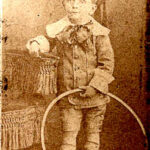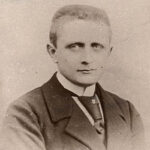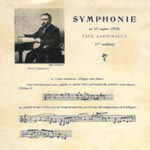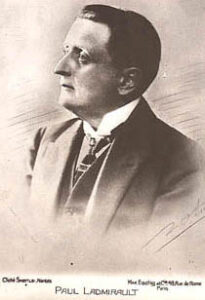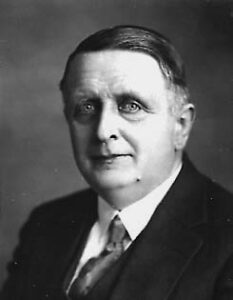Born in Nantes on december 8th, 1877, he makes his secondary education in his birthplace.Very quickly he posts a deep leaning for the music and enters to the Academy of Nantes where he unanimously obtains at 16 years old a first price of harmony.
The same year, he presents his first opera Gilles de Retz, in Nantes. The press shouts with the wonder “extraordinary musical event…” Le progrès de Nantes.
In 1899, he’s 22 years old, he unanimously obtains at the Academy of Paris a first price of harmony, then he works the counterpoint and the fugue with Gédalge. He enters then in the class of Gabriel Fauré. In this class reigned a favourable atmosphere to the blooming of the virtue of artist who refuse any concession and flatness. Paul Ladmirault will never forget his Master nor his school-fellows: Ravel, Schmitt, Laparra, Aubert, Enesco…
It is then the Parisian years during which the young composer affirms an original and attaching talent, taking part with varied and personal productions in this marvellous and rich efflorescence of the French music of the beginning of the century.
In 1903, he is then 26 years old, the National Company of Music gives in the first hearing “Le Choeur des Âmes de la Forêt” whose Claude Debussy wrote about in Gil Blas “Le Chant des Âmes de la Forêt of Mr Ladmirault to which the dreaming and fine musical quality testifies to a true nature of artist…”
In 1905, it is the Suite Bretonne taken from his original opera Myrdhin (Merlin). Fauré and Ravel liked much this work which contributed to the reputation of the composer.
The brilliant Parisian career of Paul Ladmirault continues with Brocéliande au Matin played in Le Châtelet in 1909 directed by Gabriel Pierné. The reception is enthusiastic and one can read in Le Journal du Soir :
“…it is a very luminous symphonic poem of spring grace, of a great freshness of inspiration…”
Here comes the great storm of 1914-1918. Four terrible years during which the delicate nature of the composer is put up badly with the life of the poilus…
He nevertheless finds time to write a ballet “The Prêtresse de Korydwen” which will be played at the opera in 1925.
After this long absence, Paul Ladmirault returns in his family not aspiring for more than quietness and silence.
He knows that it will have the fate of the dreamers, it doesn’t matter, nobody will prevent him from composing his own music.
In 1918, he is then 41 years old, he finishes the Roman de Tristan, stage music, for the play of Bédier and Artus. Created in 1919 in Nice, it will be repeated the same year in the Théâtre Sarah Bernhard. Success is complete, tells us Artus, and we hope that the Roman de Tristan will ensure glory to the composer. The press is not mistaken there: “the music of Paul Ladmirault expresses with as much passion as poetry all the suave beauty of the Celtic country. The following year the PASDELOUP concerts play for the first time the RHAPSODIE GAËLIQUE directed by Rhené BATHON.
In this work in five pieces, Paul Ladmirault lets burst his love for Brittany and his passion for the celtism.
In 1920, he is 43 years old, he’s nominated as professor at the Academy of Nantes. The voice of the artist is not kept silent therefore; Untiring worker, he reconciles the requirements of professorship to the constraints of creation.
January 1932, Paul Ladmirault is 55 years old. The Symphonic orchestra of Paris directed by Eugène Bigot, plays “En Forêt”. It is a triumph. The press is unanimous to regard this work as one of best of Paul Ladmirault.
At this point in time Paul Ladmirault turns to the chamber music, always in search of his ideal of clearness and concision: “Too many notes adds nothing …”he said.
Popular Gaelic music has always seduced Paul Ladmirault, always in search of the original color of the Scottish music without never calling upon the folklore, around 1930 he composes his famous QUATUOR A CORDES. Three of the four movements are of popular inspiration served by a penetrating poetic direction. Only the Andante, composed in 1904 on the name of Fauré, is completely different. This quartet offers a very original example of the fortunate association between erudite art and popular music, where any music takes its source.
At 58 years old, during his holidays in KERBILI (56), he writes 7 pieces for piano LES MÉMOIRES D’UN ÂNE according to the Comtesse de Ségur.
A little later he dedicates to his friend ENESCO a very beautiful sonata for violin and piano, played at the National Company in 1934 by ENESCO himself: “All those who will play the remarkable sonata of Paul Ladmirault, Sylvain Pons says, will note that it sings and moves by the quality of its musical ideas and their implementation, without concession to any fashion”. Among his colleagues in the Academy of Nantes, two large artists of talent : the violoncellist Robert Laffra and the clarinettist Victor Graf.
He dedicates a sonata to them : the famous sonata for violoncello and piano and that not less famous one for clarinet and piano. Composed in 1942, two years before his death this sonata for clarinet and piano is of a great limpidity of writing.
Although he was a convinced christian, animated of a major faith, Paul Ladmirault composed only one work of sacred music MESSE BREVE.
This mass of a poignant sincerity was written at 60 years old for the ordination of his son Daniel. His last works were a quintet for wind instruments and piano, a modal imagination for violin and piano.
On the 30th of october 1944, Paul Ladmirault died out in his old family residence of Kerbili, in Camoël, in Morbihan.
His disappearance like his life, did not make noise. The war in its nonsense condemned him to anonymity, but are we certain that it had not wished it this way ?

